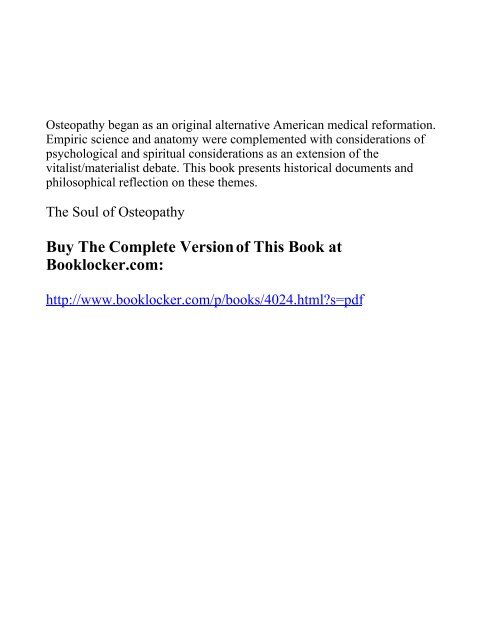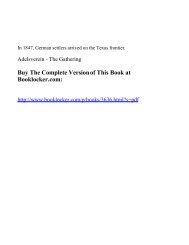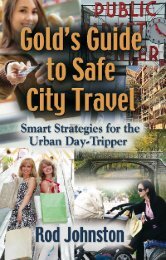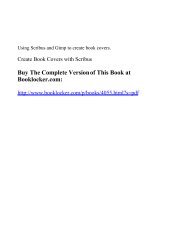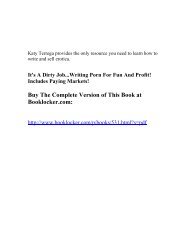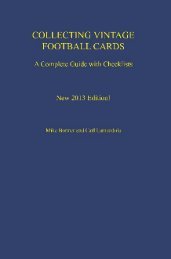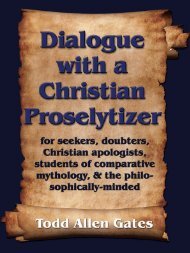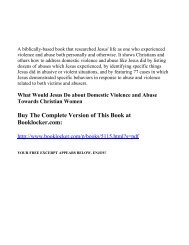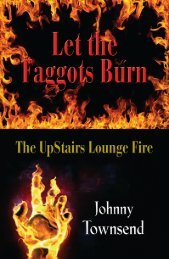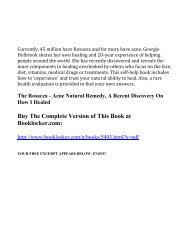The Soul of Osteopathy - The Book Locker
The Soul of Osteopathy - The Book Locker
The Soul of Osteopathy - The Book Locker
Create successful ePaper yourself
Turn your PDF publications into a flip-book with our unique Google optimized e-Paper software.
<strong>Osteopathy</strong> began as an original alternative American medical reformation.<br />
Empiric science and anatomy were complemented with considerations <strong>of</strong><br />
psychological and spiritual considerations as an extension <strong>of</strong> the<br />
vitalist/materialist debate. This book presents historical documents and<br />
philosophical reflection on these themes.<br />
<strong>The</strong> <strong>Soul</strong> <strong>of</strong> <strong>Osteopathy</strong><br />
Buy <strong>The</strong> Complete Version <strong>of</strong> This <strong>Book</strong> at<br />
<strong>Book</strong>locker.com:<br />
http://www.booklocker.com/p/books/4024.html?s=pdf
<strong>The</strong> <strong>Soul</strong> <strong>of</strong> <strong>Osteopathy</strong>:<br />
<strong>The</strong> Place <strong>of</strong> Mind in Early<br />
Osteopathic Life Science<br />
Including reprints <strong>of</strong> Coues’ Biogen<br />
and H<strong>of</strong>fman’s Esoteric <strong>Osteopathy</strong><br />
with contemporary explanatory<br />
prefaces by<br />
Zachary Comeaux DO
Copyright Zachary Comeaux DO<br />
ISBN 978-1-60145-729-5<br />
All rights reserved. No part <strong>of</strong> this publication may<br />
be reproduced, stored in a retrieval system, or<br />
transmitted in any form or by any means,<br />
electronic, mechanical, recording or otherwise,<br />
without the prior written permission <strong>of</strong> the author.<br />
Printed in the United States <strong>of</strong> America.<br />
<strong>Book</strong><strong>Locker</strong>.com, Inc.<br />
2009<br />
For additional copies, go to <strong>Book</strong>locker.com or<br />
zacharycomeaux.com
Contents:<br />
Introduction ...................................................1<br />
Part 1: Biogen: a speculation on the origin and<br />
nature <strong>of</strong> life ...............................................9<br />
Contemporary Preface to Biogen......................10<br />
Biogen: a speculation on the origin and nature<br />
<strong>of</strong> life .......................................................22<br />
Part 2: Esoteric <strong>Osteopathy</strong> ............................77<br />
Contemporary Preface to Esoteric <strong>Osteopathy</strong> ...78<br />
Esoteric <strong>Osteopathy</strong>………………………………………… 101<br />
Part 3: Epigenetic Noetic Virus ...................... 126<br />
v
Introduction<br />
Introduction<br />
Though not part <strong>of</strong> the business <strong>of</strong> everyday practice,<br />
osteopathy from the beginning, as part <strong>of</strong> its scope and<br />
focus, has included the definition and understanding <strong>of</strong><br />
the human person. This included the question <strong>of</strong> “What<br />
is Life.” This philosophical theme is reflected in the<br />
words <strong>of</strong> A. T. Still,<br />
“No one knows who the philosopher was that first<br />
asked the question, What is life. But all intelligent<br />
people are interested in the solution <strong>of</strong> this problem.”<br />
1<br />
<strong>The</strong> question arose in the context <strong>of</strong> Still’s appreciation<br />
<strong>of</strong> social and scientific advances <strong>of</strong> his century and his<br />
desire to apply science in the osteopathic clinical<br />
context <strong>of</strong> improving quality <strong>of</strong> life and health.<br />
Throughout human experience there are two<br />
intertwined efforts in the quest to reconcile science and<br />
philosophy. <strong>The</strong> one asks us to accept our material<br />
character as the complete description <strong>of</strong> who we are by<br />
nature, and one views man as additionally possessing a<br />
soul which draws him to a higher purpose, to strive to<br />
be more, to fulfill a destiny. Classically we see this<br />
latter theme set down in Greek mythology in <strong>The</strong><br />
Odyssey, and the myth <strong>of</strong> Prometheus. <strong>The</strong> Genesis<br />
account <strong>of</strong> the fall from the Garden <strong>of</strong> Eden reflects the<br />
intricacies <strong>of</strong> this same theme. In early Christian times<br />
the competition for a proper place for Man in the<br />
1
<strong>Soul</strong> <strong>of</strong> <strong>Osteopathy</strong><br />
universe was reflected in the orthodox approach to<br />
faith versus the Gnostic belief that salvation came from<br />
a certain type <strong>of</strong> esoteric, or hidden, knowledge.<br />
In the field <strong>of</strong> science, Einstein’s wrestling with the<br />
relationship <strong>of</strong> light, energy and matter attempted to<br />
expand our understanding <strong>of</strong> the physical universe, a<br />
modern quest for the Holy Grail. In our own day the<br />
Human Genome Project and the quest for a cancer cure<br />
may reflect this same dynamic to understand the big<br />
picture.<br />
In all this searching there arises a dilemma between<br />
the acceptance <strong>of</strong> tangible reality as the completeness<br />
<strong>of</strong> existence, or on the other hand, the allowance for<br />
the reality <strong>of</strong> unseen, or unrecognized, forces. <strong>The</strong><br />
struggle has been defined in the past as the dialectic<br />
between the vitalist and materialist point <strong>of</strong> view.<br />
Throughout the historical progress <strong>of</strong> the field <strong>of</strong><br />
inquiry which acknowledges the legitimacy <strong>of</strong> the<br />
unknown, there have been the Essenes, the Gnostics,<br />
the followers <strong>of</strong> Paracelsus, Rosicrucians, Masons,<br />
<strong>The</strong>osophists all claiming to possess uncommon<br />
knowledge <strong>of</strong> the unseen behind everyday reality.<br />
Dr. Still, founder <strong>of</strong> osteopathy, placed himself in the<br />
company <strong>of</strong> these searchers. He associated as a<br />
freemason, although his independence <strong>of</strong> thought<br />
made him a renegade there, too, and he was<br />
sometimes challenged in his loyalties. In an editorial in<br />
the Journal <strong>of</strong> <strong>Osteopathy</strong> in 1901 he defends the<br />
practice <strong>of</strong> Masonic secrecy, but in the context <strong>of</strong><br />
religious tolerance. He ends the editorial with:<br />
2
Introduction<br />
“It is much to be hoped that we will some day have<br />
something better than masonry, and that the church<br />
from Mahomet down will give way to something better,<br />
and all rally around the flag on whose face you read<br />
‘ Love thy neighbor as thyself’.”<br />
Still uses the name <strong>of</strong> God hundreds <strong>of</strong> times and<br />
praises Christianity. Why did he not pr<strong>of</strong>ess a Christian<br />
church affiliation, especially as the son <strong>of</strong> a Methodist<br />
preacher?<br />
Still’s unorthodox view <strong>of</strong> health and healing led him to<br />
be rejected by the denominational churches, in fact to<br />
be denounced from the pulpit.3 His early practice<br />
struggled under the weight <strong>of</strong> this stigma.<br />
Since Still’s proclaiming osteopathy in 1874, the<br />
esoteric theme and the contested boundary between<br />
physics and metaphysics has been an element <strong>of</strong> the<br />
quest to define the scope <strong>of</strong> osteopathic practice. Still<br />
several times describes osteopathy as the science <strong>of</strong><br />
mind, matter and motion. Still would reflect on looking<br />
to discover the health in the patient by the correct<br />
relationships between tissues. This addresses the<br />
matter and motion components <strong>of</strong> his science, but<br />
what <strong>of</strong> the mind? If one reads carefully, one finds Still<br />
interpreting anatomical finding and relationships as<br />
reading the mind <strong>of</strong> God in nature, in the anatomical<br />
design <strong>of</strong> the patient.<br />
This rather lengthy quote, also from the 1901 Journal<br />
<strong>of</strong> <strong>Osteopathy</strong>, captures these relationships better than<br />
I can find in his lengthier texts:<br />
3
<strong>Soul</strong> <strong>of</strong> <strong>Osteopathy</strong><br />
“What is God? If all <strong>of</strong> man, with his mind, matter and<br />
motion, is one being, what is the universe but a being?<br />
It has mind, matter and motion. It does its work well<br />
and wisely, still it is only one universe. <strong>The</strong>n mind to<br />
the universe is the same that mind is to man. This God<br />
would be the universe. We are in the universe<br />
therefore, we are with God and help compose that<br />
great all, and journey as it journeys. That great<br />
composite is eternal, and so are we. We have lived, do<br />
live and will live out the full number <strong>of</strong> days <strong>of</strong> the<br />
universe. Thus to us a universe means all space and all<br />
therein contained. This signifies the universal universe.<br />
Man under the same law <strong>of</strong> reasoning would be a<br />
dependent universe, while the universal universe is not<br />
dependent, because it is the all <strong>of</strong> all, specially and<br />
universally, mental, motor and material. <strong>The</strong><br />
individuality <strong>of</strong> mind with its independence <strong>of</strong> all else,<br />
to me seems to be impossible, because <strong>of</strong> the superior<br />
endowments <strong>of</strong> the mind over motor, which motor is<br />
above material in quality, but not at all its superior<br />
mentally. Thus both the physical and mental submit to<br />
the higher principle, which makes a unit <strong>of</strong> the three;<br />
matter, motion, and mind. Thus the universe is a being,<br />
with the mental, motor and material combined, and<br />
leaving the management <strong>of</strong> all under the mental. Thus<br />
we have God as mind in union, working in union with<br />
the motor and physical.” 4<br />
However, the conventional way <strong>of</strong> interpreting the<br />
essence <strong>of</strong> osteopathy is as if Still were solely directing<br />
us to study our physical anatomy. And he does drive us<br />
to study anatomy. However, there is more to following<br />
Still in the development <strong>of</strong> his practice than anatomy in<br />
the conventional sense. Still derived some information<br />
4
Introduction<br />
from study, but he was also described as a telepath.<br />
Furthermore, he was reported to maintain contact with<br />
a medium, Matah, the Indian.<br />
Most early osteopathic texts claimed to be following<br />
and represent the content <strong>of</strong> Still’s teaching by<br />
describing osteopathy primarily as an organized system<br />
<strong>of</strong> procedures. Barber, McConnell, Hazzard, all describe<br />
osteopathy primarily from the point <strong>of</strong> view <strong>of</strong><br />
technique. Indeed, little <strong>of</strong> that writing reflects the<br />
broader quest to explore the nature <strong>of</strong> life and man’s<br />
participation in it.<br />
Still himself explores that theme in the chapter in the<br />
Philosophy and Mechanical Principles <strong>of</strong> <strong>Osteopathy</strong><br />
entitled “Biogen”. He describes a life force in the<br />
context <strong>of</strong> a dualistic approach to the nature <strong>of</strong> man.<br />
“All material bodies have life terrestrial and all space<br />
has life, ethereal or spiritual life. <strong>The</strong> two, when united,<br />
form man.”<br />
And later:<br />
“A man, biogenic force, means both lives in united<br />
action…Thus we say biogen or dual life, that life means<br />
eternal reciprocity that permeates all nature.” 5<br />
But how did Still come to conceptualize the human<br />
experience in these terms? Still’s style was rarely to<br />
reference his sources. For a frontiersman, the scope <strong>of</strong><br />
his written discourse seemed scattered; however, to<br />
the astute investigator it demonstrates that Still was<br />
either well read or otherwise well informed as to the<br />
5
<strong>Soul</strong> <strong>of</strong> <strong>Osteopathy</strong><br />
scientific and philosophical ideas <strong>of</strong> his days. His<br />
apparent ramblings are in actuality his best attempt at<br />
synthesizing a broad spectrum <strong>of</strong> complex ideas<br />
presented by a host <strong>of</strong> thinkers.<br />
<strong>The</strong> current book is to be read as a companion to Still’s<br />
Philosophy and Mechanical Principles <strong>of</strong> <strong>Osteopathy</strong>. It<br />
includes a reprinting <strong>of</strong> the full text <strong>of</strong> Coues’ Biogen; a<br />
Speculation in the Origin and Nature <strong>of</strong> Life (1874)<br />
which predates Philosophy and Mechanical Principles<br />
(1992) and in someway was no doubt Still’s source <strong>of</strong><br />
the term.<br />
Who was Elliot Coues? What was his contribution to<br />
nineteenth century science? How did Still access his<br />
work? <strong>The</strong> introduction to this text will deal with this<br />
and related issues.<br />
This book includes a second frequently overlooked<br />
work, Herbert H<strong>of</strong>fman’s Esoteric <strong>Osteopathy</strong>. H<strong>of</strong>fman<br />
writes directly on the topic <strong>of</strong> Mind and its role in<br />
osteopathic treatment. I had mentioned Still’s having<br />
contact with a psychic medium or guide. Still wrote <strong>of</strong><br />
this in his notebooks which have subsequently been<br />
destroyed by his family to avoid an appearance <strong>of</strong><br />
mental unbalance or eccentricity. 6 Interestingly<br />
enough, H<strong>of</strong>fman’s small book, from the early era <strong>of</strong><br />
osteopathy, also showing Indian influence.<br />
Who was H<strong>of</strong>fman’s mentor in regard to this subject?<br />
Was it Andrew Still?<br />
<strong>Osteopathy</strong> has over the years evolved a panoply <strong>of</strong><br />
techniques and philosophical points <strong>of</strong> view, from<br />
6
Introduction<br />
stressing biomechanical approaches to more subtle<br />
work. Often these are seen as contradictory or at least<br />
competing as the true paradigm. <strong>The</strong> current work<br />
seeks to bring forth some little known evidence that<br />
the osteopathic approach to health was based on an<br />
understanding <strong>of</strong> the need to bridge these two<br />
paradigms, not to establish a competition between<br />
them.<br />
How relevant are these topics? Today we wrestle with<br />
the frontier between pharmacologic and alternative<br />
medicine, between bioscience as self-organization <strong>of</strong><br />
matter, with consciousness as an emergent property <strong>of</strong><br />
biomolecular complexity, versus a creationist belief in<br />
intelligent design. Twenty-five hundred years ago the<br />
philosopher commented that there is nothing new<br />
under the sun. How true is this today?<br />
As Part 3 I have included an essay <strong>of</strong> my own, written<br />
about ten years ago but as yet unpublished. It revisits<br />
the long view <strong>of</strong> the vitalist/materialist controversy but<br />
brings it into era <strong>of</strong> proteomics and genetic<br />
determinism.<br />
In a more practical vein, we know that mentation,<br />
everyday social and mental activity, is not uniform<br />
throughout life. Certainly our early developmental<br />
phases reflect this thought. But more and more, as we<br />
become more sophisticated with life support and<br />
resuscitation, the question <strong>of</strong> “what is life” has a more<br />
poignant application for many <strong>of</strong> us. Cerebrovascular<br />
accidents, temporary hypoxia, or progressive dementia<br />
leave millions alive yet without “normal” mental life<br />
and function. How to make sense out <strong>of</strong> this phase <strong>of</strong><br />
7
<strong>Soul</strong> <strong>of</strong> <strong>Osteopathy</strong><br />
Contemporary Preface to Biogen<br />
<strong>The</strong>re are few guides for the student who looks beyond<br />
the anatomic/biomechanical interpretation <strong>of</strong><br />
osteopathy according to Dr. Still. However, one is<br />
immediately excited, if one has been intrigued by Still’s<br />
description <strong>of</strong> Biogen in his wrestling with the concepts<br />
<strong>of</strong> body-mind- spirit, when one discovers Coues. Elliot<br />
Coues’ publication (1884) certainly predates Still’s<br />
publication <strong>of</strong> <strong>The</strong> Philosophy and Mechanical Principles<br />
<strong>of</strong> <strong>Osteopathy</strong> (1901). Coues lays claim to credit in<br />
coining the term biogen. Since Still would not cite<br />
references, we know little directly about how Still came<br />
to use the term, biogen, in approaching the problem <strong>of</strong><br />
“what is life?”<br />
Did they have direct contact? Kirksville was on the<br />
active rail line and a busy center <strong>of</strong> therapeutic activity.<br />
Once he left Virginia as a youth, Still’s travels eastward<br />
were limited to his participation in the 1903 Columbia<br />
Exposition in St. Louis. By the time <strong>of</strong> his writing <strong>of</strong> his<br />
monograph on Biogen, Coues, as we will see in<br />
reviewing his biography, was ensconced solidly in the<br />
Washington intellectual community. His days as an<br />
explorer <strong>of</strong> the American West as an army surgeon and<br />
scientific field <strong>of</strong>ficer were behind him.<br />
An analysis <strong>of</strong> the text does not help greatly. On an<br />
initial reading, there seem to be minimal conceptual<br />
links. <strong>The</strong> setting and occasion for the use <strong>of</strong> the word<br />
is different. Still’s eclectic style in writing, or compiling,<br />
his books places chapters in random juxtaposition<br />
10
Biogen<br />
creating a literary collage. Still’s Biogen chapter rests<br />
between Fevers and Smallpox. Still begins his chapter<br />
on Biogen by setting the stage to help osteopathy fit in<br />
with nineteenth century modernity and rapidly<br />
expanding technological and scientific progress. He<br />
ends it with reflections on the negative effects on<br />
man’s evolutionary development <strong>of</strong> war as the<br />
slaughter <strong>of</strong> the fittest.<br />
Coues, on the other hand, is working in dialogic fashion<br />
with several previous presenters to the Washington<br />
Philosophical Society in reviewing and refining the<br />
perennial vitalist/materialist argument on the divide<br />
between physics and metaphysics. <strong>The</strong> main body <strong>of</strong><br />
the text is written in Socratic fashion with an appeal to<br />
common experience and current scientific ideas,<br />
including the now quaint but then advanced concept <strong>of</strong><br />
luminiferous ether, the medium for transmission <strong>of</strong><br />
light. He does so with an urgency to call for balance in<br />
the face <strong>of</strong> the rapidly rising shift in science to limit<br />
thought related to biology only to physico-chemical<br />
considerations. He sees the scope <strong>of</strong> biological science<br />
to be much broader. His analysis is <strong>of</strong> necessity more<br />
rational and organized than Still’s. In his appendix, he<br />
is more direct and succinct in describing his view <strong>of</strong> the<br />
relationship between body, soul and spirit.<br />
One could assume that with this rather loose<br />
congruence between the two writers, beyond the<br />
common use <strong>of</strong> the word, that Still picked up the<br />
concepts and topic from discussion with a third party,<br />
such as his old friend and intellectual mentor, Colonel<br />
James Abbott. Abbott was born and educated in the<br />
East and shared Still’s interest in science and<br />
11
<strong>Soul</strong> <strong>of</strong> <strong>Osteopathy</strong><br />
philosophy. <strong>The</strong>y encountered one another as members<br />
<strong>of</strong> the Kansas Legislature, militia, and in founding<br />
Baldwin College. <strong>The</strong>re would have been plenty <strong>of</strong><br />
occasions for intellectual discussion and Abbott is cited<br />
by Still in his Philosophy <strong>of</strong> <strong>Osteopathy</strong> among a short<br />
list <strong>of</strong> major influences. 1<br />
Beyond this scope <strong>of</strong> inference, there are some details<br />
and key phrases in the texts, as we will see below,<br />
which may suggest that Still had encountered a copy <strong>of</strong><br />
the written presentation <strong>of</strong> Coues’ Biogen: a<br />
speculation on the origin and nature <strong>of</strong> life.<br />
Coues career<br />
Although he began and ended his intellectual career in<br />
the nation’s capital, Coues was not a salon philosopher.<br />
His early love <strong>of</strong> nature led him at seventeen to sign<br />
aboard the schooner Charmer to study maritime<br />
wildlife in Labrador. Encouraged by his lifelong patron<br />
and mentor, Spencer Baird, assistant secretary <strong>of</strong> the<br />
Smithsonian Institution, Coues would become one <strong>of</strong><br />
the foremost <strong>of</strong> American ornithologists. Birding, in<br />
those days was done by the search, shoot, inspect,<br />
skin and classify method. Coues’ Key to North<br />
American Birds includes taxonomy but also instruction<br />
on preparing specimens, and principles <strong>of</strong> biology,<br />
included his theory <strong>of</strong> biogen.<br />
<strong>The</strong> real drama <strong>of</strong> Coues’ life unfolded as he served as<br />
a medical <strong>of</strong>ficer and field biologist for the U.S. Army in<br />
Colorado and Arizona. Identification <strong>of</strong> new species was<br />
done with an eye out for Apache Indians anxious to<br />
retain and regain their home territory. Serving in a role<br />
12
Biogen<br />
similar to Lewis and Clark, Coues medical duties were<br />
minimal and he regularly shipped hundreds <strong>of</strong> new<br />
species east, including new species or sub-species <strong>of</strong><br />
birds and mammals. His related publications fill<br />
volumes.<br />
Of more interest to us here is his affiliation with<br />
Freemasonry which began in 1867 during a deployment<br />
in South Carolina. This would reflect a sensitive but<br />
philosophically variant view from orthodox religion, <strong>of</strong><br />
which he was known to be critical. However, it is not<br />
until his address to the Washington Philosophical<br />
Society, the transcript <strong>of</strong> which we have here in this<br />
book, that Coues makes a definitive break with<br />
conventional science <strong>of</strong> his day. After this date, he<br />
became more expressive <strong>of</strong> his broader world view. He<br />
became acquainted with Madame Helena Blavatsky,<br />
the popularizer and charismatic founder <strong>of</strong> the<br />
<strong>The</strong>osophical Society, an eastern/western syncretism <strong>of</strong><br />
occult practice. Coues was, in 1885, to become the<br />
president <strong>of</strong> the society, also serving in the same<br />
period as the censor, or literature reviewer, for the<br />
American Society <strong>of</strong> Psychical Research. During this<br />
period he was a prolific writer and frequent conference<br />
speaker on topics related to spiritual science and<br />
related topics. This, and the Freemason connection he<br />
shared with Andrew Still, could easily have made his<br />
thought visible in print to an exploring and curious<br />
Andrew Still.<br />
Few in the spiritualist circles appreciated the effort<br />
Coues made to reconcile the apparently esoteric sphere<br />
with that <strong>of</strong> empiric science. So, later in life, he<br />
returned to the field <strong>of</strong> biological science and the<br />
13
<strong>Soul</strong> <strong>of</strong> <strong>Osteopathy</strong><br />
history <strong>of</strong> western exploration, writing biological<br />
definitions for the Century Dictionary and material for<br />
the Encyclopedia Britannica before becoming involved<br />
in the controversial reediting <strong>of</strong> the Journals <strong>of</strong> Lewis<br />
and Clark, <strong>of</strong> Zebulon Pike as well as early French and<br />
Spanish explorers.<br />
Gist <strong>of</strong> Coues’ Biogen argument<br />
Elliot Coues takes issue with the emergent perspective<br />
in bioscience that looked at protoplasm as the basic<br />
element and condition <strong>of</strong> life. It had been proposed by<br />
advancing science that life is concomitant with<br />
protoplasm, formed spontaneously and advanced by<br />
the progressively complex aggregation <strong>of</strong> chemical<br />
elements, for us the “emergent property” hypothesis.<br />
“Biology has proven that Life was a mode <strong>of</strong> matter<br />
and motion, ergo, protoplasm was the life principle;<br />
and it has just upon the point <strong>of</strong> being discovered by<br />
the Society, when the protoplasm, which the Society<br />
had examined, died. So the vital principle had given<br />
them the slip.”<br />
Coues makes a different proposal. Existential<br />
awareness <strong>of</strong> oneself as conscious and operative is the<br />
motivation for Coues to speak. He develops an<br />
argument to align one’s consciousness as an operative<br />
power and reference point which in itself, because <strong>of</strong><br />
its cogency, is self-validating in a way that the regional<br />
succession <strong>of</strong> chemical actions can never be. In so<br />
doing, he reaffirms that this critical self-consciousness<br />
is both evidence <strong>of</strong> an undefined vital force, which can<br />
be potentially evaluated by science, in much the same<br />
14
Biogen<br />
way as science <strong>of</strong> the times was coming to accept the<br />
“luminiferous ether” as a way <strong>of</strong> understanding the<br />
phenomenon <strong>of</strong> light. At the same time, he cites that<br />
this universal cogency <strong>of</strong> the self-awareness <strong>of</strong> human<br />
kind is linked through the will to motion- all motion -<br />
and to Universal Mind. Simultaneously, he uses this<br />
self evident conviction to reaffirm the perennial and<br />
universal phenomenon <strong>of</strong> faith, including faith in the<br />
ultimate and supreme consciousness, God, as an<br />
essential element <strong>of</strong> scientific cosmology.<br />
Although this is Coues’ main argument, Still would be<br />
compatible with it but does not cite it in the<br />
development <strong>of</strong> his own thought. However as<br />
mentioned before, there are key phases on a more<br />
physical, less psychological basis, which bind the two<br />
presentations together and hint at some contact by<br />
Still, at least with Coues’ written text.<br />
From Still<br />
“We see the form <strong>of</strong> each world, and call the united<br />
action biogenic life. All material bodies have life<br />
terrestrial and all space life ethereal or spiritual life.<br />
<strong>The</strong> two, when united, form man.” 2<br />
From Coues<br />
“….spirit…I have postulated that it actually does exist,<br />
and defined it as self conscious force (biogen). I have<br />
speculated that a living body results from the action <strong>of</strong><br />
spirit on matter and that life subsists on the union <strong>of</strong><br />
the two.” 3<br />
From Still<br />
15
<strong>Soul</strong> <strong>of</strong> <strong>Osteopathy</strong><br />
“Thus we say biogen or dual life, that life means<br />
eternal reciprocity that permeates all nature.” 4<br />
Motion<br />
Both authors refer to the aspect <strong>of</strong> life represented<br />
by motion. Each reflects a familiarity with the<br />
philosophy, physics and cosmology <strong>of</strong> Herbert<br />
Spencer, an important philosopher <strong>of</strong> that era.<br />
Coues make the argument however, that there<br />
needs to be a cause for motion, or a moving system,<br />
calling on the Aristotelian concept <strong>of</strong> a First Cause.<br />
And so:<br />
“Force cannot act where it is not; neither can it act<br />
with nothing to act upon; its presence and<br />
operation upon matter are, therefore, necessary<br />
conditions <strong>of</strong> its manifestation; all the<br />
manifestations <strong>of</strong> life are ultimately resolvable into<br />
modes <strong>of</strong> motion, and in the particular modes <strong>of</strong><br />
motion exhibited by living things, and by no others,<br />
are evidenced the presence and operation <strong>of</strong> the<br />
vital principle, the energy <strong>of</strong> which differs from<br />
other energies precisely as the modes <strong>of</strong> motion <strong>of</strong><br />
living things differ from those <strong>of</strong> all things that do<br />
not live.”<br />
A familiarity with Spencer is also disclosed by the<br />
reverence which the two men have for the<br />
unknowable.<br />
16
Spirit<br />
Biogen<br />
Still’s sense <strong>of</strong> spiritualism and telepathy, though<br />
attested by family members and friends, are hidden in<br />
his language. Echoing his previous work Still cites:<br />
“First there is the material body; second, the spiritual<br />
being; third, a being <strong>of</strong> mind which is far superior to all<br />
vital motions and material forms, whose duty it is to<br />
wisely manage this great engine <strong>of</strong> life.” 6<br />
He gives little detail regarding the sense <strong>of</strong> the spirit<br />
per se, recapitulating the argument for a “celestial<br />
force” underlying life processes. 7<br />
But Coues is concentrating on a different argument,<br />
the relevance <strong>of</strong> which should be apparent in our day.<br />
He was concentrating on a rebuttal to the position that<br />
protoplasm, the simplest evidence <strong>of</strong> life, was proposed<br />
to be what we call today an emergent property <strong>of</strong> selforganized<br />
matter. <strong>The</strong> chemico-physical explanation for<br />
this proposed that physiologic motion, concomitant<br />
with life, was a result <strong>of</strong> the instability occurring with<br />
larger and more complex aggregations <strong>of</strong> matter. <strong>The</strong><br />
Darwinist point <strong>of</strong> view <strong>of</strong> survival <strong>of</strong> the most adaptive<br />
carried the rest <strong>of</strong> the argument. Coues most<br />
fundamental reply to this is to cite the impossibility <strong>of</strong><br />
the random occurrence <strong>of</strong> a system which could then<br />
self-replicate. To say that a biological system could<br />
spontaneously organize in a way that continued by<br />
laying its own egg was a scientifically untenable, and<br />
non demonstrable, position.<br />
17
<strong>Soul</strong> <strong>of</strong> <strong>Osteopathy</strong><br />
Especially in the appendix, as you will see, Coues<br />
develops a psychology/cosmology which related his<br />
concept <strong>of</strong> biogen, spirit, matter, soul in such a way as<br />
to suggest that biogen is an extended capacity <strong>of</strong><br />
matter, and not really a dualistic way <strong>of</strong> viewing the<br />
world, the usual vulnerable attribute <strong>of</strong> a vitalistic<br />
theory.<br />
Both Still and Coues invoke the importance <strong>of</strong> Mind in<br />
living organism, Coues by recognizing that awareness<br />
itself is evidence <strong>of</strong> a primary vital principle reflecting<br />
the Universal Mind. Still in turn refers to the study <strong>of</strong><br />
anatomy:<br />
“Let us accept and act on it as true, that life is that<br />
force sent forth by the Mind <strong>of</strong> the universe to move all<br />
nature, and apply all our energies to keep that living<br />
force at peace, by retaining the house <strong>of</strong> life in good<br />
form from foundation to dome. Let us read<br />
a few lines in the book <strong>of</strong> Nature. If we stop blood in<br />
transit…”<br />
Coues states, in his appendix, that “<strong>The</strong> mind is the<br />
result <strong>of</strong> interaction between spirit and matter.” And<br />
again:<br />
“Whence emanated matter in the beginning is<br />
inscrutable; from nowhere, certainly, -if not from the<br />
self-conscious, self-determining universal Mind which<br />
willed to become so manifested.” 9<br />
In the case <strong>of</strong> both authors, linkage is made through<br />
this reference to mind to the third work discussed,<br />
18
Biogen<br />
Esoteric <strong>Osteopathy</strong>, by Herbert H<strong>of</strong>fman discussed as<br />
part two <strong>of</strong> this current book.<br />
Current thought<br />
So what is the relevance <strong>of</strong> this discussion for us<br />
today? In the not too distant past, Robert Fulford, DO,<br />
taught and operated under the presupposition that<br />
“thoughts are things” and had an impact for good or ill<br />
on the etheric or energetic body. His treatment relied<br />
upon the use <strong>of</strong> intention or mental activity as an<br />
operational principle capable <strong>of</strong> potent interaction with<br />
the patient. He had read Reichenbach as had Coues<br />
some generations before. 10<br />
In the time since physics has advanced in its<br />
understanding <strong>of</strong> light and biochemical bonds, these<br />
issues seem archaic. However, the field <strong>of</strong> condensed<br />
matter physics is today a viable discipline as is the field<br />
<strong>of</strong> prebiology involved with the evolution <strong>of</strong><br />
macromolecules and genetically orchestrated selforganization<br />
<strong>of</strong> molecular systems, let alone galaxies.<br />
<strong>The</strong> term intelligent matter seems to counter Coues<br />
argument for a distinction between mind and<br />
protoplasm. Coues would side with what we now call a<br />
creationist world view. Contemporary attempts to<br />
reconcile the vitalist/ materialist conflict include the<br />
concept <strong>of</strong> theistic evolution and intelligent design.<br />
<strong>The</strong> contemporary study <strong>of</strong> the physiology <strong>of</strong><br />
consciousness has moved beyond the discovery <strong>of</strong><br />
nuclei, brain waves and neurotransmitters to the study<br />
<strong>of</strong> oscillatory synchrony and phase changes both<br />
among and between populations <strong>of</strong> neurons. Not only<br />
19
<strong>Soul</strong> <strong>of</strong> <strong>Osteopathy</strong><br />
in the brain is this recognized, but oscillatory function<br />
is held by a large number <strong>of</strong> physiologists to be the<br />
means <strong>of</strong> information transmission and coordination in<br />
living systems in general.<br />
Yet the questions are still debated. Is consciousness an<br />
emergent property <strong>of</strong> complex adaptive systems <strong>of</strong><br />
genetically elaborated proteins alone? Or is there an<br />
extrinsic or participatory aspect <strong>of</strong> psychic life which is<br />
generated by something beyond the material as we<br />
know it?<br />
Search the web and you will find that the questions<br />
and hypotheses <strong>of</strong> Still, <strong>of</strong> Coues, and <strong>of</strong> H<strong>of</strong>fman are<br />
still hot topics today.<br />
References:<br />
1. Still, A Philosophy <strong>of</strong> <strong>Osteopathy</strong>, Indianapolis,<br />
IN, American Academy <strong>of</strong> <strong>Osteopathy</strong>, 1977, orig.<br />
by author Kirksville MO 1899 p.14<br />
2. Still, A Philosophy and Mechanical Principles <strong>of</strong><br />
<strong>Osteopathy</strong>, Osteopathic Enterprises, Kirksville,<br />
MO 1986 orig. Hudson-Kimberly Pub. Co. Kansas<br />
City, MO 1902 p. 251<br />
3. Coues, E Biogen, a speculation on the origin and<br />
nature <strong>of</strong> life, Estes and Lauriat, Boston, 1884, p.<br />
45<br />
4. Still op. cit. 251<br />
5. Coues, E op. cit p. 38<br />
6. Still, op. cit. p.17<br />
7. Still, op. cit. p. 252<br />
8. ibid. p. 101<br />
9. Coues, op. cit. p. 57<br />
20
<strong>Osteopathy</strong> began as an original alternative American medical reformation.<br />
Empiric science and anatomy were complemented with considerations <strong>of</strong><br />
psychological and spiritual considerations as an extension <strong>of</strong> the<br />
vitalist/materialist debate. This book presents historical documents and<br />
philosophical reflection on these themes.<br />
<strong>The</strong> <strong>Soul</strong> <strong>of</strong> <strong>Osteopathy</strong><br />
Buy <strong>The</strong> Complete Version <strong>of</strong> This <strong>Book</strong> at<br />
<strong>Book</strong>locker.com:<br />
http://www.booklocker.com/p/books/4024.html?s=pdf


